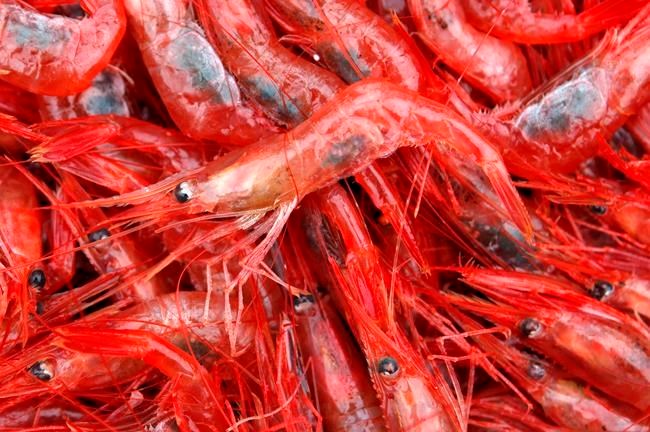MONTREAL — For years, the northern shrimp fished in the Quebec waters of the Gulf of St. Lawrence have been known as "crevettes de Matane," named after the town where much of the province's harvest has been processed since the 1960s.Â
But after the owners of the town's processing plant announced its closure this week, there's fear that it's not only the Matane shrimp that are on their way out, but the Quebec shrimp fishery as a whole.
Patrice Element, director of the shrimp industry group Office des pêcheurs de crevette du Québec, said it's hard to be surprised by the closure. Over the years, temperatures in the gulf have been rising, causing shrimp stocks to plummet and making conditions more favorable for fish species that eat them, he said.
"It's more than a worry. It's a quasi-certainty that if it continues to decline like last year, it's the end, especially with economic conditions that don't help us either," Element said in a phone interview.
Royal Greenland, owners of the seafood processing plant in Matane, announced Monday that it was closing due to a number of factors including declining shrimp stocks, as well as a lack of employees and "increasing financial challenges" including high shore prices and low market prices.
In January, the federal Department of Fisheries announced that the quota for northern shrimp stocks in the estuary and northern Gulf of St. Lawrence -- which includes parts of Quebec, New Brunswick and Newfoundland -- would be decreased to 3,060 tonnes, compared to about 14,500 tonnes in 2023.
Element said the quotas were about 35,000 tonnes as recently as 2015. What remains, he said, is enough for a handful of boats and crews, rather than the 80 or 90 that currently exist.
Marie-Julie Roux, a research scientist for the Fisheries Department, said temperatures near the sea floor, where the northern shrimp live, increased about 1.8 degrees over the 13-year period ending in 2022. While the number may seem small, it’s “huge” for a cold-blooded species like shrimp, which can’t regulate their own body temperature and were already at the southern edge of their range in the St. Lawrence, she said.
Twenty years ago, shrimp were found throughout the gulf, “but now they're becoming a lot more concentrated in small patches where conditions are still favorable for them,” she said. “But that habitat is becoming increasingly rare.”
Given these changes, she said it’s likely the northern shrimp will become “commercially extinct” in the St. Lawrence, meaning it will continue to exist but in numbers too small to support a fishery.Â
Element said that there is some disappointment with the low quota, but fishers don't argue with the data on warming. They've seen it with their own eyes and recorded it on thermometers.
"(The temperature) is increasing, it's increasing rapidly and unfortunately it risks continuing to rise," he said.
The news of the plant closure was a blow to the 14,000-person town on Quebec's Gaspé peninsula that once held an annual shrimp festival to celebrate its connection to the industry.
Matane Mayor Eddy MĂ©tivier said the news is "a catastrophe" for the fishers and the plant's employees, "but it's also a symbol of identity for Matane."
MĂ©tivier said that while the industry's troubles are nothing new, the closure was a shock because Royal Greenland had recently upgraded its facilities to expand into crab and lobster transformation and built new housing for the roughly 150 temporary workers -- mostly Mexican -- who work there every year.
He said the federal government's decision to reimpose visas on Mexican nationals -- at a time when this year's cohort was "almost in the airplane" -- was the final straw for Matane's industry, and he blamed a lack of communication between the immigration and fisheries departments for not leaving enough time to adjust.
Jean-Paul Gagné, the general director of an association representing Quebec's fishing industry, said there has been little good news in recent years for fishers, who have been forced to adapt again and again to changes in climate and water quality. But not all species do poorly in warming water.
One glimmer of hope is the rising numbers of lobster moving into the gulf, as well as the reopening of the commercial redfish fishery this year for the first time since 1995. Redfish, which can live in warmer temperatures, are also a shrimp predator, he noted.
Gagné said some harvesters and plants may be able to switch to different species although that takes investment in equipment, skills, marketing and probably government aid. Even then, there's no guarantee it will pay off, he said, noting the newly abundant lobster could eventually move on if the temperature continues to rise.
"There are big decisions to take, and it's hard for everyone," he said.
MĂ©tivier said he hopes that a buyer will come forward for the closed Royal Greenland plant. Perhaps one day, once the visa issue is sorted, we'll even talk about "Matane lobster" or "Matane redfish" instead of Matane shrimp, he said.Â
It would take a company ready to invest. "But there's lots of new equipment in the factory," he said.
This report by The Canadian Press was first published March 20, 2024.
Morgan Lowrie, The Canadian Press



